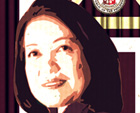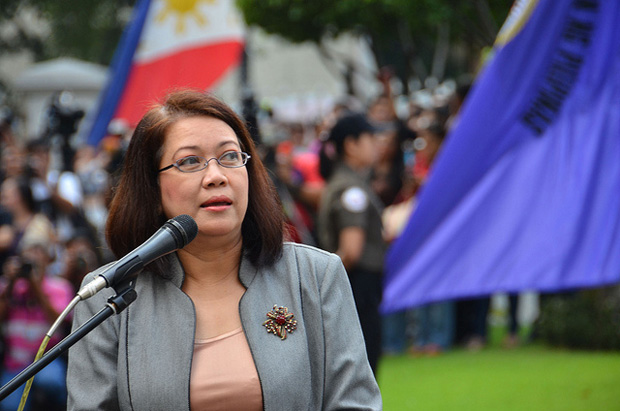MARIA LOURDES P.A. Sereno, appointed on August 24, 2012, graced history as the first female chief justice of the Supreme Court of the Philippines. Following the impeachment drama a few months ago, which found former Chief Justice Renato Corona guilty, she stood as a vessel of restoration and reform as she picked up the pieces of the Supreme Court’s past.
Knowledge about her as chief justice only runs skin deep, as she stands by her principle of “dignified silence” as a leadership style in the highest court of the land. This silence is shattered, however, when her colleagues speak. Who is Chief Justice Sereno behind the doors of the Supreme Court?
In the workplace
With a lot of pressure on her shoulders, Sereno is more than determined to redirect the path of the Supreme Court by fueling her 18-year mandate with integrity.
In an email interview with The GUIDON, Lawyer Lourdes E.B. Oliveros, chief-of-staff of the Office of the Chief Justice, says that Sereno is hands-on when it comes to her work and that she built a team comprised of different people who are experts in their respective fields.
Furthermore, Oliveros shares how the chief justice emphasizes on the changes she wishes to implement. “The CJ inspires integrity and excellence in the workplace, and is highly contagious in her unstinting and enthusiastic pursuit of judicial reform.”
Oliveros also cites how Sereno leads by example, inspiring the people around her with encouraging words to make things work judicially.
CJ by the minute
Oliveros explains what the chief justice does on a regular day. “She is up by 4:30 AM and for the most part, she is the last one to go home in the evenings.” This shows the effort that Sereno gives amid a demanding work schedule.
The chief justice juggles different meetings and judicial duties within a week. An example, according to Oliveros, is the en banc session that Sereno has to participate in every Tuesday. Such a schedule says a lot about how she manages her time. She is able to touch on all aspects that are under her branch.
“She still finds the time to have light-hearted conversations with her staff and make sure we’re doing all right,” adds Oliveros. The chief justice, after all, doesn’t leave an aspect untouched—she makes time for her job and her colleagues as well.
To end the rundown of Sereno’s schedule, Oliveros continues, “It’s mind-boggling how she can accomplish so much given the limitations of a 24-hour day. A lesser mortal wouldn’t last a day in her shoes.”
It can be said that the chief justice is more than just her job. She allows herself to surpass what a normal person can do in the context of work—what the Ateneo community often refers to as magis.
Blue roots
Our very own Ateneo de Manila University President Fr. Jett Villarin, SJ, had a few experiences with Sereno. “She was my classmate in philosophy. Very low key, quiet, deep, unassuming. She was a scholar with her own circle of friends from Gabay,” he recalls.
Villarin also shares that she joined study groups and was a congenial company. If she has been a naturally quiet person ever since, could this be the source of the “silence” she invokes in the Supreme Court?
“I never would have known then that she would be where she is now. I guess I never would have known then, too, that I would be where I am now,” says Villarin, who has nothing but support and kind words to say about Sereno. But aside from this unexpected turnout of events, he affirms that Sereno is setting a good example by integrating Ignatian values to her work.
Sereno is hardworking and diligent, says Villarin. He also states that he would want to believe that the Ateneo has taught her to be independent of mind, to be fearless in the face of vested interests, to be faithful to the truth and to be a humble leader.
“Dignified silence”
The GUIDON asked for an interview with the chief justice but was declined in compliance with the “policy of restoring dignified silence in the Court,” in a letter sent by her office.
Sereno has opted to avoid interactions with the media. For her, upholding the said policy would bring back the “golden days” of the Supreme Court.
Oliveros agrees with this directive. “Statements made outside of judicial pronouncements are susceptible of being misconstrued and the personal opinions of magistrates—outside of their decisions—run the risk of being interpreted as that of the judiciary as a whole,” she says.
The policy is more of a protection for the judiciary, as the chief justice and her staff want to avoid misinterpretations of their statements.
While the press may argue that freedom of information is violated, Oliveros argues that the New Code on Judicial Conduct exhorts judges to conduct themselves in such a manner that preserves the dignity of the judicial office and the impartiality and independence of the judiciary.
In Sereno’s own words to the media on her first day as chief justice, “Wisdom leads me to seek to return the Supreme Court to its days of dignified silence—when its justices were heard when read through their writings and when the actions of the court were best seen in their collective resolutions.”
The chief justice might not be a woman of many words, but it is the same dignified silence that reveals who she is and the reform she wants to deploy within and outside of the Supreme Court.





